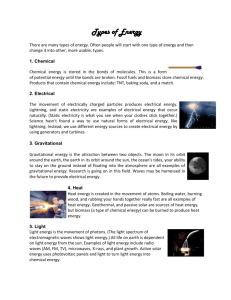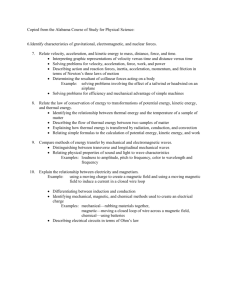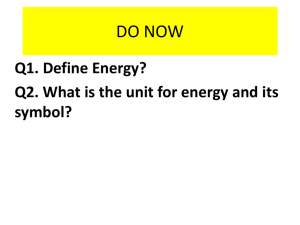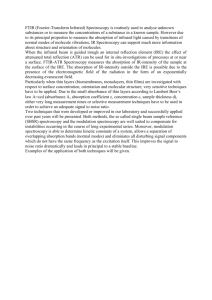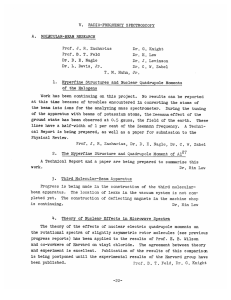IV. RADIO-FREQUENCY SPECTROSCOPY A. MOLECULAR-BEAM RESEARCH
advertisement
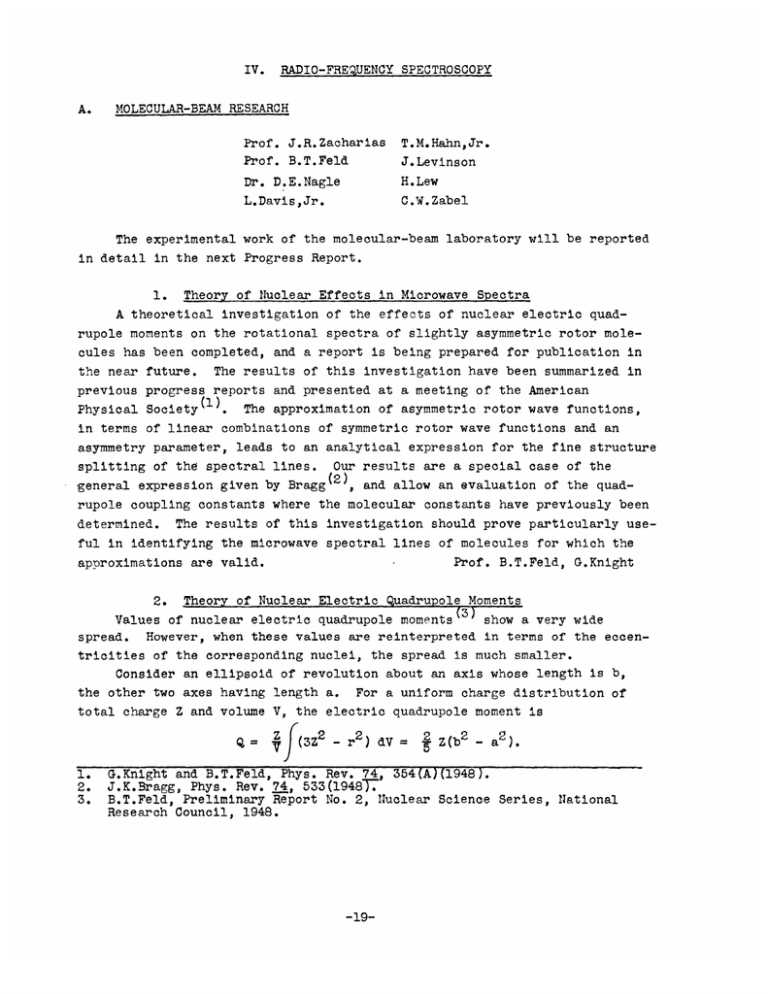
IV. A. RADIO-FREQUENCY SPECTROSCOPY MOLECULAR-BEAM RESEARCH Prof. J.R.Zacharias Prof. B.T.Feld T.M.Hahn,Jr. J.Levinson Dr. D.E.Nagle H.Lew L.Davis,Jr. C.W.Zabel The experimental work of the molecular-beam laboratory will be reported in detail in the next Progress Report. Theory of Nuclear Effects in Microwave Spectra A theoretical investigation of the effects of nuclear electric quadrupole moments on the rotational spectra of slightly asymmetric rotor molecules has been completed, and a report is being prepared for publication in 1. the near future. The results of this investigation have been summarized in previous progress reports and presented at a meeting of the American Physical Society( l ). The approximation of asymmetric rotor wave functions, in terms of linear combinations of symmetric rotor wave functions and an asymmetry parameter, leads to an analytical expression for the fine structure splitting of the spectral lines. Our results are a special case of the , and allow an evaluation of the quadgeneral expression given by Bragg rupole coupling constants where the molecular constants have previously been determined. The results of this investigation should prove particularly use- ful in identifying the microwave spectral lines of molecules for which the Prof. B.T.Feld, G.Knight approximations are valid. 2. Theory of Nuclear Electric Quadrupole Moments (3) Values of nuclear electric quadrupole moments show a very wide spread. However, when these values are reinterpreted in terms of the eccentricities of the corresponding nuclei, the spread is much smaller. Consider an ellipsoid of revolution about an axis whose length is b, the other two axes having length a. For a uniform charge distribution of total charge Z and volume V, the electric quadrupole moment is Q =Z (3Z2 - r2 ) dV = Rev. 74, Z(b2 - a 2 ). 354(A)(1948). 1. G.Knight and B.T.Feld, Phys. 2. J.K.Bragg, Phys. Rev. 74, 3. B.T.Feld, Preliminary Report No. 2, Nuclear Science Series, National Research Council, 1948. 533(1948. -19- I (IV. _ 1 - RADIO-FREQUENCY SPECTROSCOPY) We define the ellipticity as: b-a and take the nuclear radius to be (for small ellipticities) R = = 1.5 A/3 x 10- 1 3 cm o Then, £ ZR2 = _ _ = + 1 for a pencil, = - 1 for a penny. ; The deduced values of c are plotted in the accompanying curve, on which the circles indicate odd proton and the crosses odd neutron nuclei. An attempt is being made to correlate the observed quadrupole moment with the orbital angular momentum of the odd particle as indicated by the measured magnetic moment((1), (2) . The figures besides the points are the nuclear spins. I-4 ATOMIC NUMBERI Fig. IV-1. 1. 2. Deduced values of c. E.P.Wigner and E.Feinberg, Reports on Progress in Physics, A, London(1942). T.Schmidt, Zs. f. Phys. 106, 358(1937). -20- 274, (IV. B. RADIO-FREQUECY SPECTROSCOPY) MAGNETIC NUCLEAR RESONANCE Prof. F.Bitter N.Adams W.Dickinson T.Wimett 1. Nuclear Resonances at Low Temperatures Apparatus for the observation of nuclear magnetic resonances at liquidhelium temperatures is being designed and assembled. A small magnet weighing about 30 pounds and designed to be operated in liquid air has been N.Adams completed. 2. Nuclear Resonances at Room Temperatures The measurement of new nuclei requires an improvement of the signalto-noise ratio now available. In addition to the low-temperature experiments mentioned above, three different ways of making such an improvement are being investigated: (a) by increasing the volume of the sample; (b) by increasing the concentration of nuclei being studied; particularly by using fine metal powders, if possible in the molten state; (c) by making use of transient signals as previously discussed (1 ). Prof. F.Bitter, W.Dickinson 3. Deuteron-Proton Moment Ratio The factors affecting the accuracy with which this important ratio can be measured have been studied. The limits are primarily determined by the observed line width, which is set by the homogeneity of the magnetic field used, and the symmetry and constancy of the line shape which is determined by the stability of the r-f bridge circuit used. A Helmholtz coil, designed to produce fields of about 1,200 gauss uniform to a few parts in a million in a volume of several cubic centimeters, is being built. The circuitstability problems are being studied. T.Wimett 1. R.L.E. Quarterly Progress Report, July 15, 1947, page 26. -21- *1~1"1-^1 -- --~----rs~-~-y -^rr^_----rrr~-~ ~-r- (IV. C. --_---ra~-r~..l~---~--r RADIO-FREQUENCY SPECTROSCOPY) PARAMAGNETIC RELAXATION Prof. A.F.Kip R.D.Arnold 1. Resonance Absorption The measurement of resonance absorption in CuSO4 *5H20 and CuK 2 (S04 )2 6H20 single crystals in a static magnetic field has been completed. An RLE technical report (No. 61) is in press and an article has been submitted to The Physical Review. 2. Absorption in the Absence of a Static Magnetic Field Gorter (1) and coworkers have investigated the absorption in paramagnetic substances at low frequencies and with no applied static magnetic field. Equipment limitations prevented their reaching frequencies of the order of the reciprocal of the relaxation time. Our next experiment, therefore, will be to study the behavior of the absorption as a function of frequency in this range. The results may shed some light on several as-yetunanswered questions on the nature of paramagnetic relaxation. Absorption is to be measured by observing the change in Q of a resonant cavity in which a sample is placed. A cavity designed to be adjustable from 300 Mc to 600 Mc is under construction, and others for higher frequencies will follow. Two methods are being considered for separating the magnetic and electric losses: (a) to apply a static magnetic field, perpendicular to the r-f magnetic field, sufficiently large to quench the magnetic absorption, or (b) to move the sample in the cavity from a region of high magnetic field to one of high electric field. D. MICROWAVE SPECTROSCOPY Prof. G.G.Harvey Prof. A.G.Hill Prof. M.,W.P.Strandberg J.G.Ingersoll H.R.Johnson J.R.Eshbach R.B.Lawrance B.V.Gokhale C.C.Loomis M.T.Weiss R.E.Hillger G.W.King 1. General A good deal of the work of the past three months has been devoted to equipment repair and construction. A high-temperature waveguide system has -22- (IV. RADIO-FREQUENCY SPECTROSCOPY) been constructed for use with high-boiling-point molecules, and for enhancing the population of the higher vibrational states. This system, because of mechanical limitations, can by used only up to 18000C, and improvements for higher-temperature operation are now under way. This system will be used first for further work on OCSe, and for work on the spin of Hg isotopes. M.T.Weiss A cavity system is being prepared for use with rare molecules, and for Zeeman spectra. Some difficulty has been experienced in introducing mechanical modulation. Balanced phase detectors are used to eliminate the amplitude modulation so produced. This system will probably be used first with molecules containing isotopes of Cobalt 59 and 60. C.C.Loomis Work on molecules containing tellurium has been carried on with no positive results. Search for lines of the (CH3)2 Te molecule in the region of the spectrum where such lines might be expected to lie has yielded nothing so far. Recent misbehaviors of the spectroscope may be due to breakdown of the molecule, and a resulting deposition of Te on the insulators. Other possible molecules, namely OCTe, SCTe and HDTe are probably unstable. R.E.Hillger The Cs experiment reported in some detail in the October 15 Progress Report is now completed, and an account is being written for publication. Work on the high-pressure spectrum of 02 has been written up for publication. Work on the low-pressure and Zeeman spectra is starting. M.W.P.Strandberg, B.V.Gokhale, J.H.Ingersoll 2. Spin of Boron Some work on borine carbonyl (H3 BCO) is in progress. The J = 1--2 transition for this molecule has been reported by Gordy, Ring and Burg(l) They obtain a good fit to the observed quadrupole structure by assuming a spin for boron of 3. There is interest in checking this for the J = 0--)1 transition where only a simple triplet structure is to be observed. The spin in this case is determined from the fine-structure spacing and relative intensities. We have observed the J = 0-+1 transition for H3BCO but,as yet, have not resolved any fine structure greater than about 1 Mc/sec. Rotational transitions have been observed with the molecule in excited vibrational states and the Stark effect and dipole moment determined. moment is of the order of 0.5 debye units. 1. W.Gordy, H.Ring, A.Burg, Phys. Rev. 74 1191(1948) -23- The dipole LII -L__~..~~^..-l_^_i .._-_1 ___^..^.I (IV. RADIO-FREQUENCY SPECTROSCOPY) The detection system used in those experiments is very sensitive, compared to published figures for systems elsewhere. The sensitivity is about 10- 8 cm 1 with a bandwidth of 1000 cps. We have narrowed this bandwidth to about 10 cps where the minimum detectable a is 10cm- 1 . Figures of min = 5 x 10 - 0 m - 1 , for bandwidth of a fraction of a cycle per second, have been reported. The minimum discernible a is proportional to the bandwidth in our system since phase is preserved in all detection processes. Briefly, the system combines a high-frequency FM modulation which is much greater than the line breadth, with a Stark-absorption modulation. The signal is detected in a crystal and amplified at the FM modulation frequency plus or minus the Stark-modulation frequency. The theory of the system is too complex to be described here, but it will appear as a technical report in the near future. It is hoped to finish work on H3 BCO in the immediate future and then to proceed to finish up work pending on formaldahyde, ketene, and pyridine. M.W.P.Strandberg 3. Hyperfine Structure of Atomic Hydrogen As previously stated, the purpose of this experiment is to study, by means of Zeeman effect, the absorption by atomic hydrogen of microwaves in the region of 1421 Mc. The absorption coefficient has been calculated theoretically and comes out to be of the order of (8.6) 10- 9 C cm- 1 or (3.7) 10- 3 c db/km, where e is the fraction of hydrogen atoms which can be maintained in the cavity. The formula for a completely resolved Zeeman component is 2 2 2 e h .1j 1 Nv2 apeak 12m2 c 3 k 0o 21 + 1 TA where N is the number of atoms per unit volume, I is the nuclear spin ( for hydrogen), Av is the half-breadth at half intensity, and the transition dipole matrix element Pij/po is a numeric, equal to unity for hydrogen. The principal uncertainity in the numerical value of a comes from the kinetic-theory estimate of Av, and a principal experimental difficulty is in keeping the fraction of atoms large. Comparing this absorption coefficient with that of cesium allows us to estimate that the hydrogen value is about an order of magnitude smaller than that for the average well-resolved cesium line. sible to observe the effect. Thus it should be just pos- (IV. RADIO-FREQUENCY SPECTROSCOPY) The cardinal importance of maintaining a high fraction of atoms has made necessary a reinvestigation of agents for poisoning the cavity walls, the electrodes, and the pumping lead. Contrary to expectations, it appears that ordinary Lubriseal stopcock grease is quite effective in poisoning even brass against recombining hydrogen atoms. The apparatus is now being reassembled. Further study has been made of klystron noise. The low-frequency (26 cps) noise of a klystron is markedly greater on the high-voltage side of the mode. A method has been devised for measuring the relative amounts of amplitude and frequency fluctuations in the klystron output. R.B.Lawrance 4. The Asymmetric Rotor a. Extension of the Calculation of Energy Levels In a paper submitted to the Journal of Chemical Physics, various methods of computing the energy levels of the asymmetric rotor are reviewed for values of high angular momentum which are required in the interpretation of infrared and microwave spectra. A table of values of J = 11 and ,<1. Methods of 12 is given and over the whole range of asymmetry -1) using the Correspondence Principle, Mathier functions, harmonic oscillator matrices, and power series expansions are discussed, and this survey indicates there is always a region of some degree of asymmetry where the exact value has to be obtained from the rigorous matrix-mechanical formulation. Methods of obtaining energy values for small intervals in f from exist- ing tables are also discussed. G.W.King -25-


